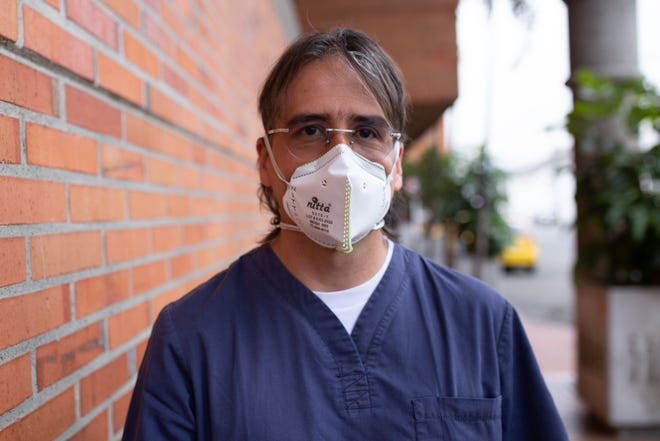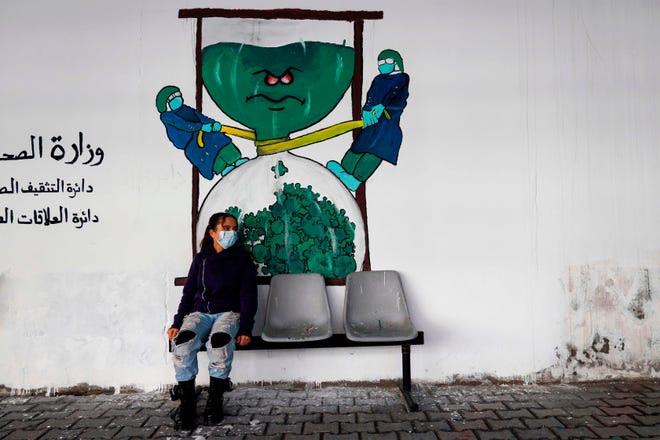While images of people lined up for long-awaited COVID-19 vaccinations spurred hope in millions across the globe, they stirred up something else in Dr. Juan Jose Velez: frustration.
Velez runs the coronavirus ward in one of the biggest public hospitals in Colombia, a country with one of the highest death rates and positivity rates in the world.
While more than 152 million COVID-19 vaccine doses have been administered globally, with roughly a third of those in the U.S., according to Bloomberg’s vaccine tracker, Colombia is among a number of lower- to middle-income countries that still had not administered a single dose by mid-February.

“I think the greatest thing this has shown us is the lack of solidarity …. the fact that lots of countries have started vaccinating, while many poorer countries haven’t even started,” Velez said.
This disparity is playing out across the world, and it’s one health experts have warned of since the onset of the pandemic: While richer countries rapidly vaccinate their populations and buy up doses, other nations are projected to not have wider access to the vaccine until late 2022 or 2023, according to the World Health Organization (WHO).
‘On the brink of a catastrophic moral failure’
While some efforts are being made to close that gap, WHO officials warn vaccine nationalism – where countries prioritize vaccination of their own citizens over the rest of the world – has put the world “on the brink of a catastrophic moral failure.”
In his hospital in Medellín, Colombia’s second-largest city, Velez said a refrigerator that would eventually carry COVID-19 vaccine vials had arrived, but it was still uncertain when he and other medical staff on the frontlines would have access to their first shot. He said he lost count months ago of how many of his patients died.
Dr. Salim Abdool Karim of South Africa was one of the first to warn of vaccine disparities.
At the onset of the pandemic, he called for a “global public good.”
“The alternative is what we have now: which is countries scrambling, those with deep pockets going and out-bidding others to get vaccines, and everyone is in a race to buy up vaccines,” said the infectious diseases epidemiologist, who has worked on HIV/AIDS and polio in Africa. “So middle-income countries, lower-income countries, they just fold their arms and say, what are we going to do, we don’t have vaccines.”
He told USA TODAY he’s concerned, but not shocked, at the inequality that has emerged.
President Joe Biden on Thursday announced a deal to purchase an additional 200 million coronavirus vaccine doses.
“We’ve now purchased enough vaccine supplies to vaccinate all Americans,” Biden said.
In addition to finalizing contracts with Pfizer and Moderna for 100 million more doses each that will be delivered by the end of July, Biden said 100 million other doses that were supposed to arrive in June will now be delivered in May.
“That’s a month faster,” Biden said. “That means lives will be saved.”
To fulfill his promise of administering 100 million vaccine shots in his first 100 days, Biden has taken steps both to increase production of vaccines and improve vaccination rates. Biden said Thursday that goal will be surpassed.
Despite high vaccination rates, disparities have also emerged within the U.S. People of color have suffered disproportionate rates of COVID-19 cases, hospitalizations and deaths as a result of longstanding systemic inequities and racism. A lack of data is further masking vaccination rollout transparency, health equity researchers say, and the data deficit is hurting those most vulnerable. So far, only 16 states are releasing vaccination counts by race and ethnicity, and the data is incomplete. Early findings show states that rank high on COVID-19 vulnerability indexes are falling behind on vaccinations.
‘Just not equal at all’: Vaccine rollout in Chicago a microcosm of racial disparities nationwide
OPINION:The hard truth about Black America and the COVID vaccine
In Britain, more than 12 million people have now had at least one dose of a coronavirus vaccine. Officials say they are on track to offer first doses to 15 million in the top priority groups by Monday, and have set a target of vaccinating every adult in the country by the fall.

In Israel, vaccines were made available to all citizens over the age of 16 last week.
It has thus far delivered over 3.5 million first doses of the Pfizer vaccine and at least 2.1 million second doses in a push to inoculate most of its population since late December.
Tel Aviv has also started administering vaccines free of charge to the city’s foreign nationals, many of whom are undocumented asylum seekers.
While the vaccination campaign has won praise internationally for its quick pace, WHO has also raised concerns that it does not include Palestinians in the occupied West Bank and the blockaded Gaza Strip.
In Africa, countries have counted lower rates of infections and COVID deaths than South America — but the new variant that originated in South Africa has brought with it a worrying uptick.
“Vaccine hoarding will only prolong the ordeal and delay Africa’s recovery,” Dr. Matshidiso Moeti, WHO regional director for Africa, said in a statement. “It is deeply unjust that the most vulnerable Africans are forced to wait for vaccines while lower-risk groups in rich countries are made safe.”
What about COVAX?
In April 2020, WHO launched the COVAX vaccination initiative with Gavi, the Vaccine Alliance, and the Coalition for Epidemic Preparedness Innovations, with a goal to distribute 2 billion doses before 2022. The aim is to ensure equitable distribution of vaccines to participating countries, regardless of income levels, and to distribute enough doses to allow countries to vaccinate 20% of their populations — largely healthcare workers and the elderly.
“That way, you avoid what in my view would be an unethical and unconscionable thing, which would be countries like the UK or the US vaccinating low-risk young people [when] countries in Africa haven’t even vaccinated their eldery,” said Abdool Karim.
“It would be completely unacceptable,” he said. Yet, he conceded, it’s probably going to happen. The world throwing its weight behind COVAX would be the best solution, he said.
Iran is planning to import some 17 million doses of vaccine from COVAX and millions from other countries. But for now, it’s using recently delivered Russian Sputnik V vaccines to vaccinate healthcare professionals. Iranian media have reported that a total of 2 million Russian vaccines will arrive in Iran in February and March.
Cambodia is set to get 7 million doses through the COVAX initiative. For now, China has donated 1 million doses of the Chinese-made Sinopharm vaccine, enough for half a million people, and the first shipment of 600,000 doses arrived in Cambodia on Feb. 7. Australia also announced a grant of $28 million to purchase 3 million doses.
WHO and global leaders have repeatedly urged richer countries to step up funding to COVAX to aid countries that have less capacity to buy doses. But those calls have been met with mixed success, said Dr. Felicia Knaul, a global health expert and economist.
Countries like Canada, which has done well to control the spread of the virus, has enough vaccines reserved to vaccinate its population four times over. The United States, the United Kingdom, Australia, Chile, New Zealand and the European Union have also locked down more vaccines than their population counts. Yet, Canada, New Zealand and Chile also elected to pull on COVAX for doses, as well, spurring criticism.
Global authorities said the move is a form of “double dipping” with vaccines – taking from a global aid scheme while also getting doses from private companies, which poorer nations may not be able to afford.
Canada’s international development minister defended the decision in an interview with CBC News in early February, saying, “Our top priority is to ensure Canadians have access to vaccines … Canada made the decision, as other countries have, to take on this first allocation, because we recognize how important it is that all Canadians have access to vaccines.”
The European Union also recently came under fire when it announced export controls on vaccines produced in its territory, which could affect around 100 countries across the world.
“COVAX, ideally, could be enough. Let’s put it this way, if all the world’s governments stepped up to support COVAX … it could be a strategy that could help to ensure equity in vaccine availability,” said Knaul. “There’s going to be a lag in timing no matter what, but it could do an amazing amount to help poor countries get access more quickly and at better prices.”
Obstacles from infrastructure to mistrust
Lower- and middle-income countries also face greater challenges when vaccines do arrive.
Abdool Karim explained that many parts of Africa don’t have the medical infrastructure to distribute the shots.
Colombia is covered by large swaths of rurality, and roadways that make it challenging to deliver basic medical services, let alone vials that require freezing cold temperatures.
While Colombia is considered a middle-income country and critics are fast to say a major cause of vaccination lags has also been government failure, it’s also one of the most unequal countries in Western Hemisphere. Meanwhile, decades of conflict spurs on endemic distrust of government bodies that would have to distribute doses.
Clemencia Carabalí, a community leader in a remote nook of Cauca, Colombia said she is “not that hopeful” vaccines will come.
“It’s always been difficult to access health services,” she said. “And for the vaccines to arrive to our land, that’s going to be really hard because of problems with intermediation and corruption. It’s possible that they’ll never arrive.”
Others, like Carlos Lopez, a director of a migrant shelter in Guatemala, said he has similar worries about migrant populations in the region because they often lack access to basic health services.
“The majority of migrants don’t have any economic resources,” he said. “They’re practically going to be the last to be taken into consideration.”
In such zones, Knaul said ensuring that citizens receive two doses will be challenging, and that countries will also need to play a balancing act in which vaccines they choose to distribute: weighing transportability, price, access, effectiveness and public trust.
In an encouraging sign for nations scrambling for the limited vaccine supply, a single shot of the AstraZeneca/Oxford University vaccine reduced transmission of the coronavirus by 67% and provided substantial protection against COVID-19 for at least three months, according to preliminary data from three trials unveiled earlier this month. Knaul and other experts said a single dose vaccine could cut back significantly on logistical hurdles and concerns that many will only get half vaccinated.
Johnson & Johnson also developed a single-dose COVID vaccine.
‘Until it is over for us all’
Despite worrying numbers, there have also been recent signs that point toward closing the gap.
Last week, UNICEF announced a deal with the Serum Institute of India that would create 1.1 billion doses of both the AstraZeneca and Novavax vaccines. The vaccines would cost $3 a dose, and go to the poorest countries in the world.
UNICEF Executive Director Henrietta Fore said that the deal was just an initial agreement, and that “more will follow.”
“For countries which have already initiated vaccination drives, and those yet to begin,” Fore said in a statement, “this information is a hopeful marker on the winding path out of a pandemic that will not be truly over, until it is over for us all.”
Contributing: Associated Press
